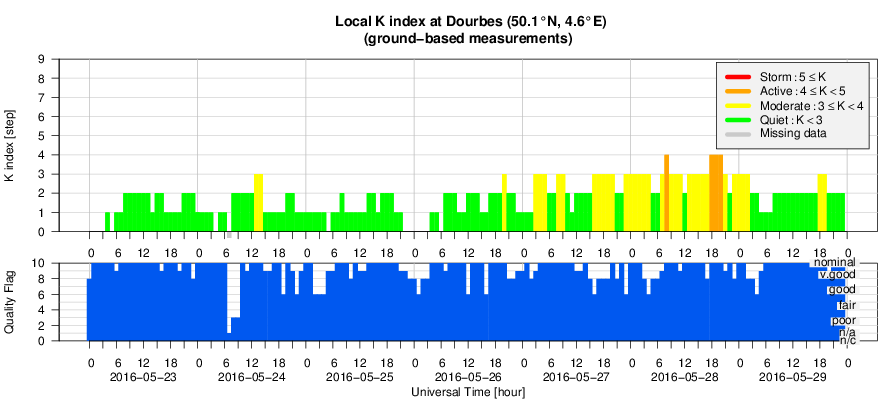- Table of Content
- 1.Quiet week, lo...
- 2.PROBA2 Observa...
- 3.Review of sola...
- 4.The Internatio...
- 5.Review of geom...
- 6.Geomagnetic Ob...
- 7.Review of iono...
- 8.Future Events
- 9.New documents ...
2. PROBA2 Observations (23 May 2016 - 29 May 2016)
3. Review of solar activity
4. The International Sunspot Number
5. Review of geomagnetic activity
6. Geomagnetic Observations at Dourbes (23 May 2016 - 29 May 2016)
7. Review of ionospheric activity (23 May 2016 - 29 May 2016)
8. Future Events
9. New documents in the European Space Weather Portal Repository
Quiet week, lovely events
Solar flaring activity was once again restricted to a handful of minor C-class flares this week. A few regions drew away all attention: Departing NOAA 2546, emerging NOAA 2548, and an active but spotless region near the Sun's east limb. Gif-movies of the individual events can be found at http://www.stce.be/news/348/welcome.html
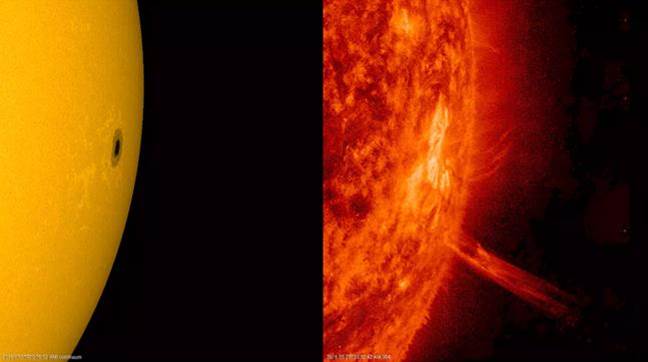
NOAA 2546 consisted mainly of a single big sunspot, with a surface area about three times that of the Earth. During its two weeks of visibility on the solar disk, it produced only three C-class flares. However, its symmetrical and simple outlook in white light was rather misleading, as extreme ultraviolet (EUV) imagery from SDO (http://sdo.gsfc.nasa.gov/ ) showed a large number of jet-like eruptions from 24 to 26 May, often -but not always- associated with minor eruptions in x-ray flux and small coronal mass ejections (CMEs). The region rotated over the southwestern solar limb late on 26 May.
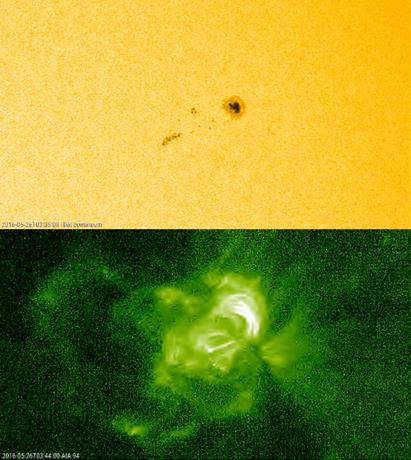
NOAA 2548 gradually emerged on disk starting 24 May, showing some interesting magnetic restructuring during its initial development. The presence of a few patches of opposite magnetic polarity near the main spot resulted in the creation of a couple of small filaments. All this activity sparked some minor B-class flaring and also one C-class flare, on 26 May peaking just 15 minutes before the C-class event in NOAA 2546. Interestingly, the main leading spot of NOAA 2548 was directed away from the solar equator, in contrast to the general rule that the leading portion of a sunspot group is located closer to the equator than the trailing portion.
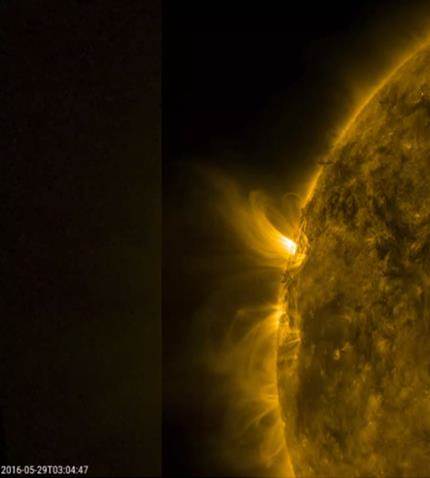
An active region does not need to have spots to produce flares or other eruptive events. Indeed, early on 29 May, a small, spotless region near the northeastern limb produced a gradual, long duration B3 event. It was associated with a very nice CME, as captured by the PROBA2/SWAP (http://proba2.oma.be/ ) and SDO/AIA EUV-telescopes. The typical post-flare coronal loops were observed, and coronagraphs revealed a nicely shaped CME. None of the aforementioned CMEs had an earth-directed component.
PROBA2 Observations (23 May 2016 - 29 May 2016)
Solar Activity
Solar flare activity has been low during the week.
In order to view the activity of this week in more detail, we suggest to go to the following website from which all the daily (normal and difference) movies can be accessed:
http://proba2.oma.be/ssa
This page also lists the recorded flaring events.
A weekly overview movie can be found here (SWAP week 322).
http://proba2.oma.be/swap/data/mpg/movies/weekly_movies/weekly_movie_2016_05_23.mp4
Details about some of this week's events, can be found further below.
Wednesday May 25
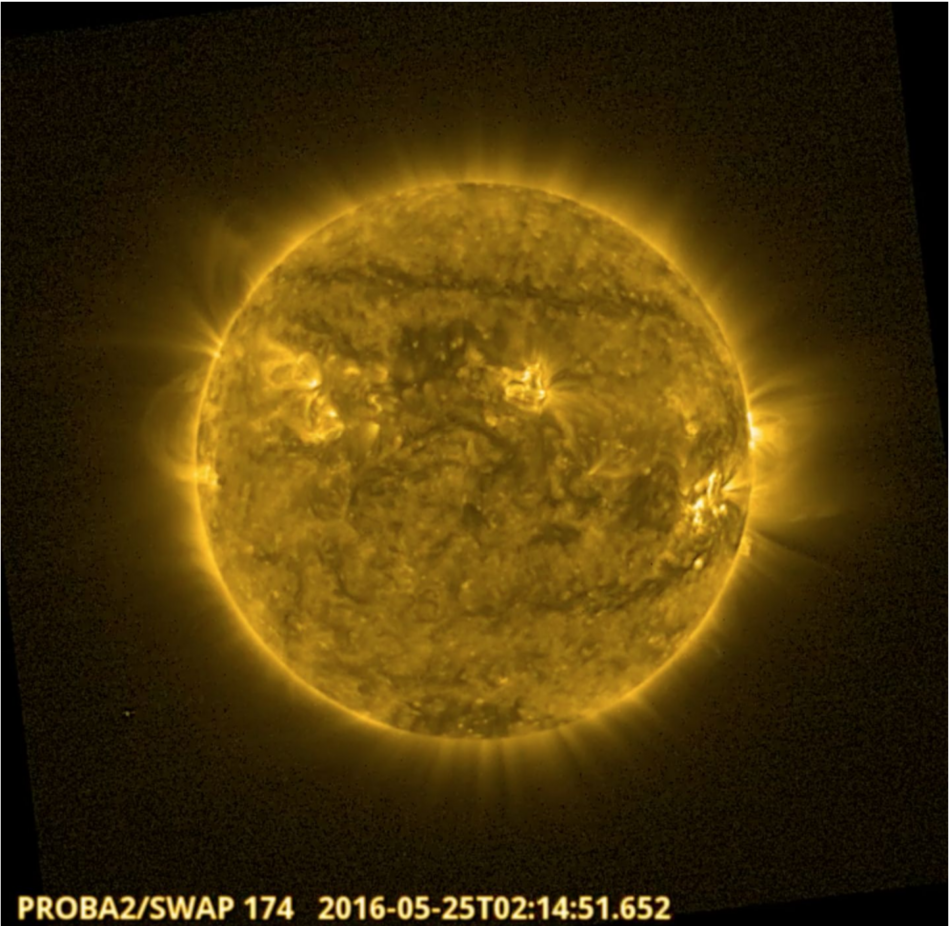
AR 2546 exhibited a series of small flares throughout the week, which were often combined with
small outward flows. The largest flow was observed when the AR was close to the West solar
limb at 02:14 UT on 2016 May 25, which can be seen in the image above.
Find a movie of the events here (SWAP movie)
http://proba2.oma.be/swap/data/mpg/movies/20160525_swap_movie.mp4
Thursday May 26
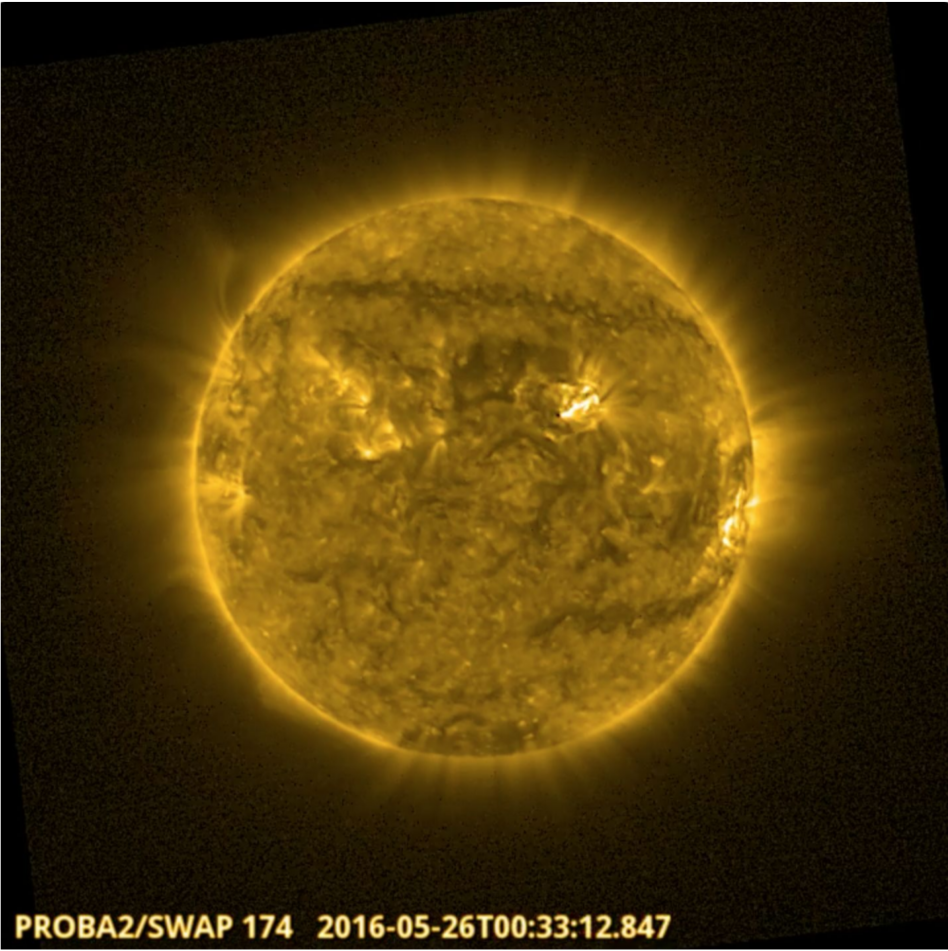
AR 2348 was relatively quiet throughout the week but produced its largest flare on 2016 May 26
when it was in the Northwest quadrant of the Sun at 00:33 UT
Find a movie of the events here (SWAP movie)
http://proba2.oma.be/swap/data/mpg/movies/20160526_swap_movie.mp4
Sunday May 29
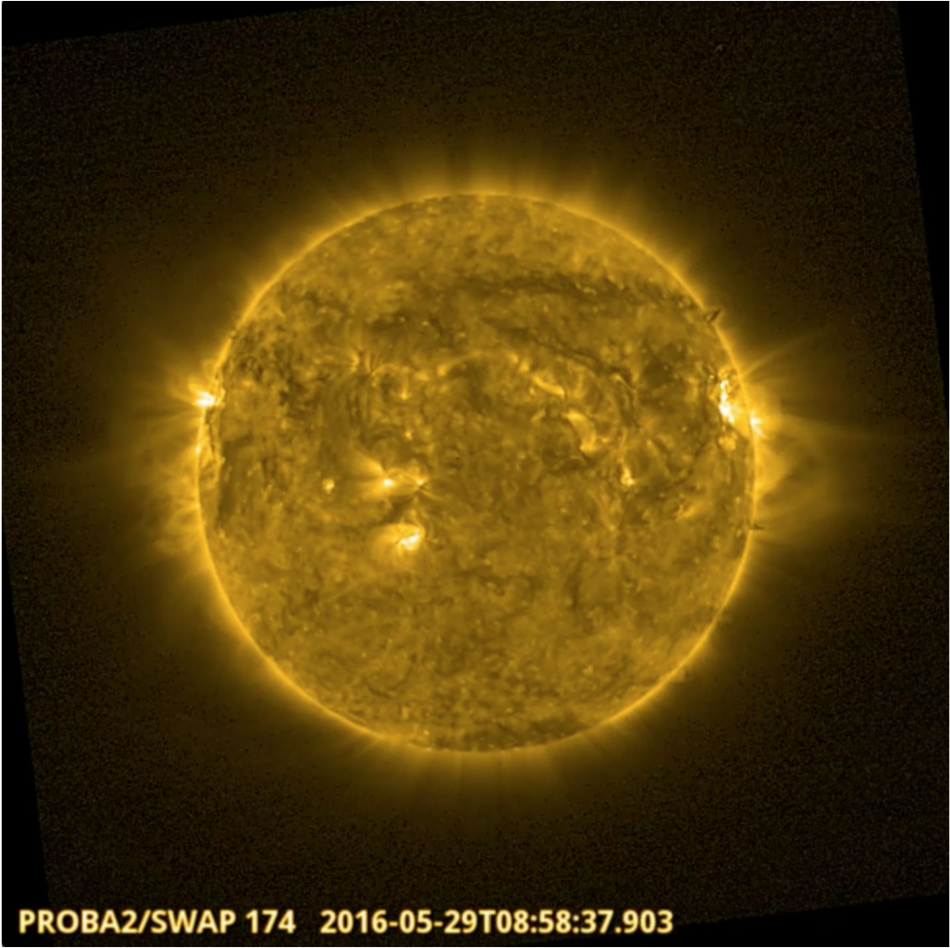
An unclassified AR rotated onto the East solar limb on 2016May29 and produced a small
eruption at 08:58 UT
Find a movie of the event here (SWAP movie)
http://proba2.oma.be/swap/data/mpg/movies/20160529_swap_movie.mp4
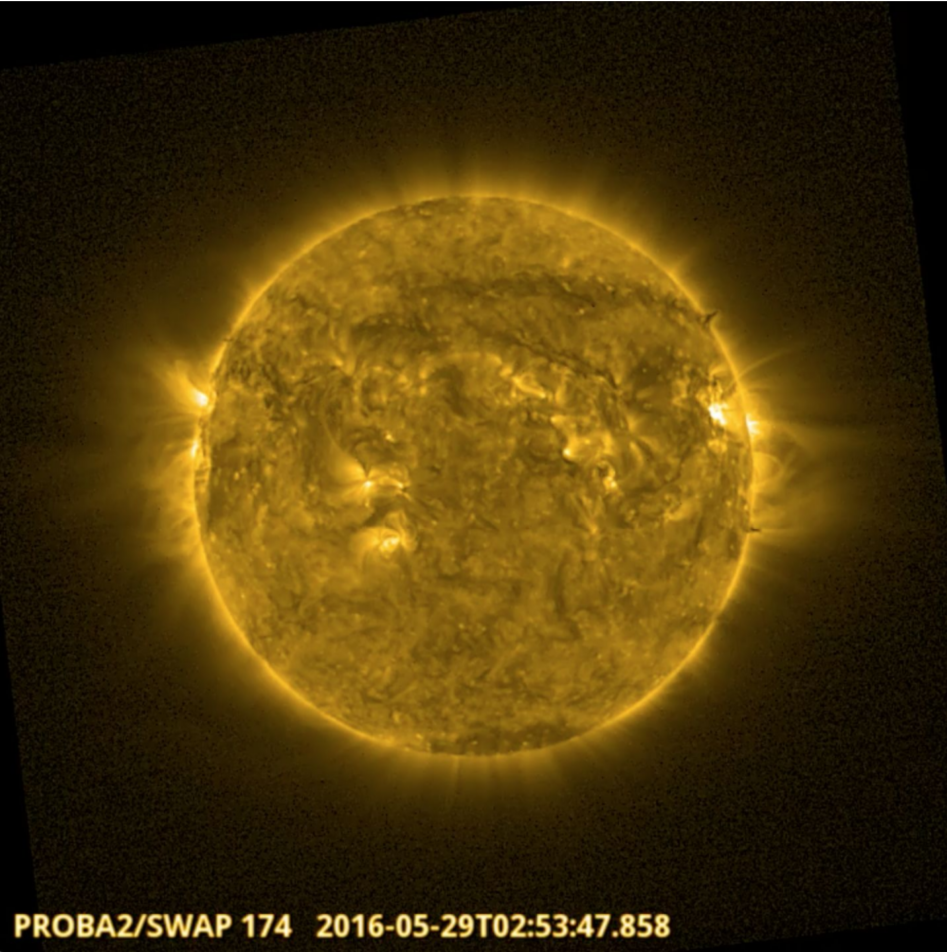
AR 2348 produced an eruption when it was located near the North West limb at 02:53 UT on
2016 May 29
Find a movie of the event here (SWAP movie)
http://proba2.oma.be/swap/data/mpg/movies/20160529_swap_movie.mp4
Review of solar activity
Only three C-class flares were observed during the past week. Big sunspot NOAA 2546 produced two C1 flares on respectively 24 and 26 May, before rotating off the solar disk late on 26 May. Several minor eruptions were observed from this region, often with jets and associated with small coronal mass ejections (CMEs). NOAA 2548 developed on disk on 24 May and produced a C1 flare on 26 May.
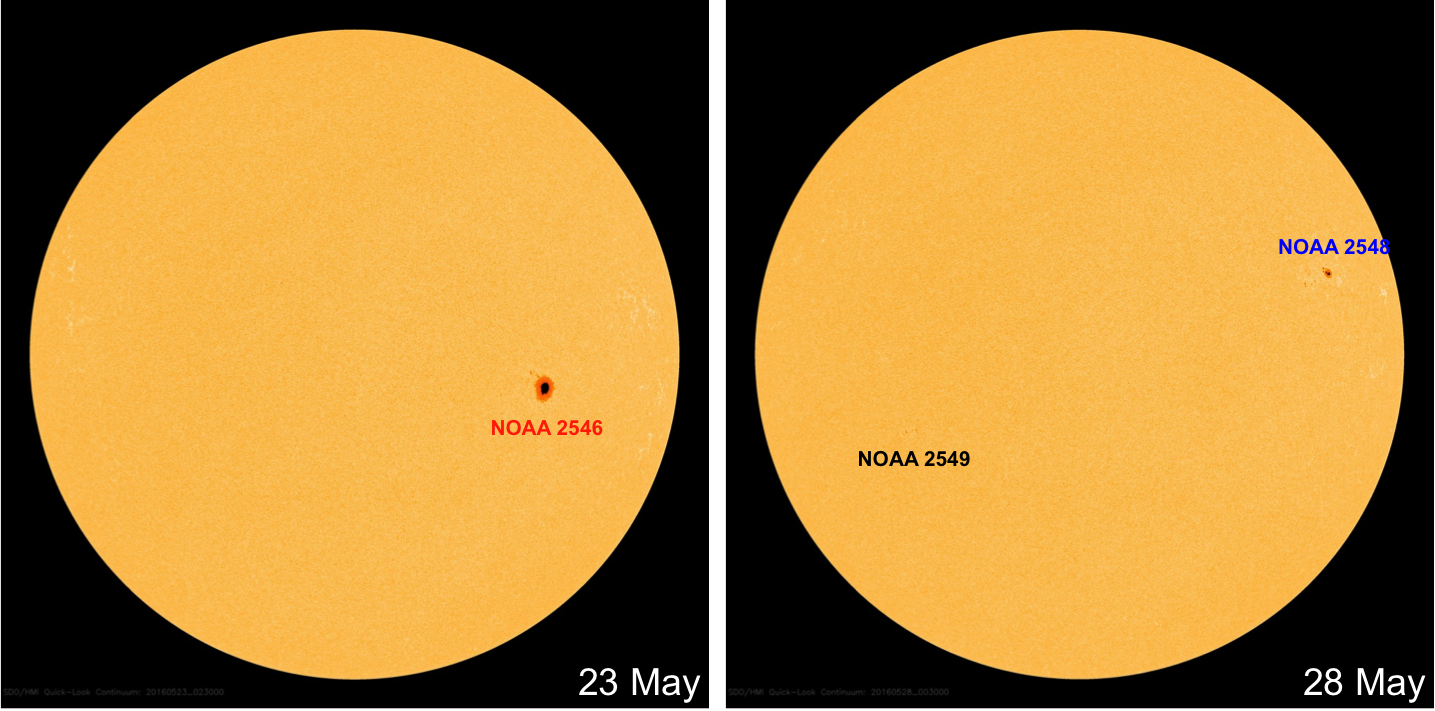
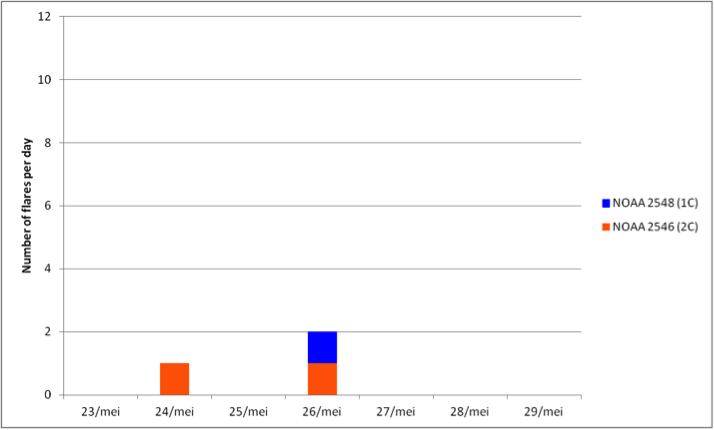
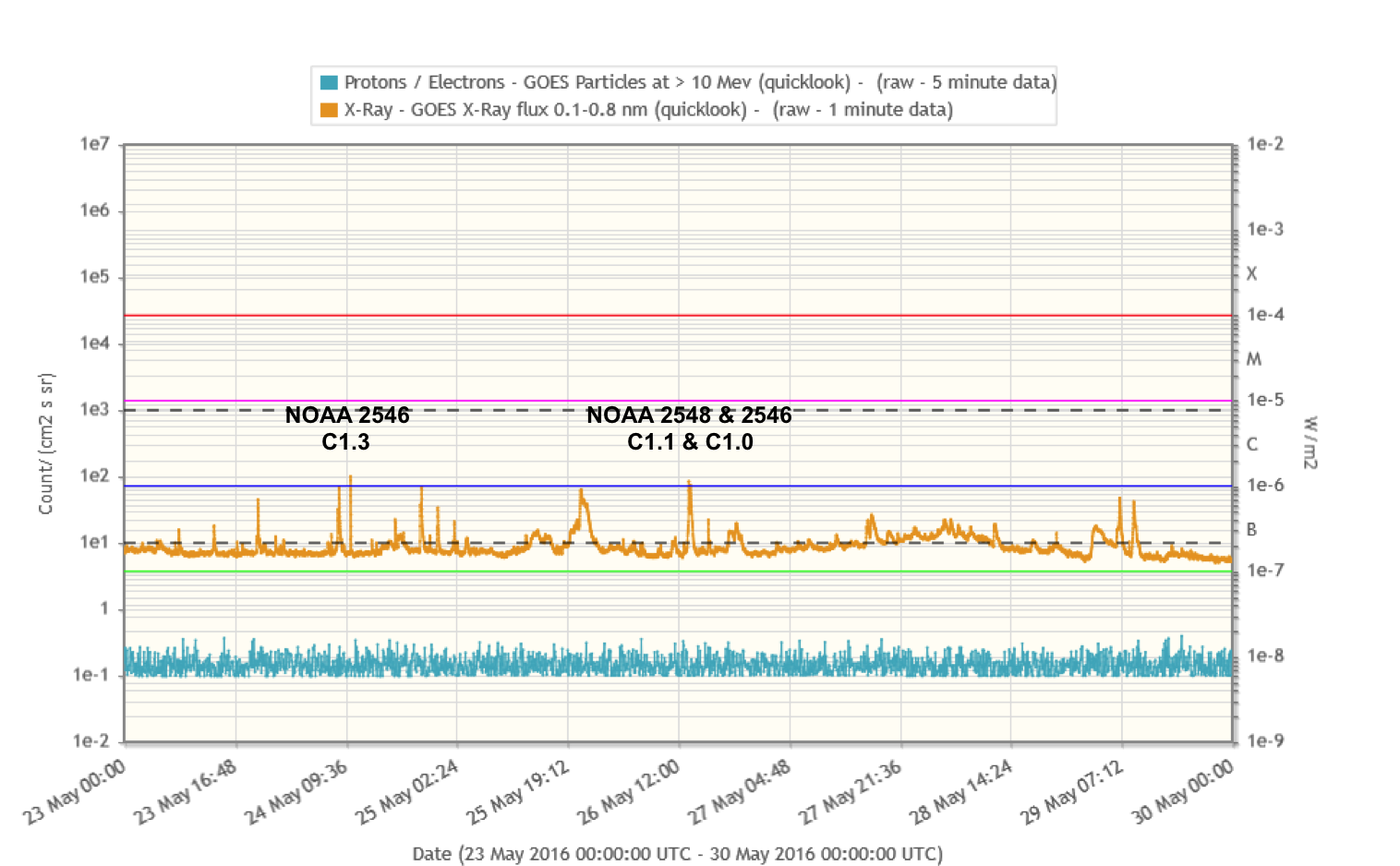
This region produced some small CMEs too mainly directed to the northwest. No earth-directed CMEs were observed.
The International Sunspot Number
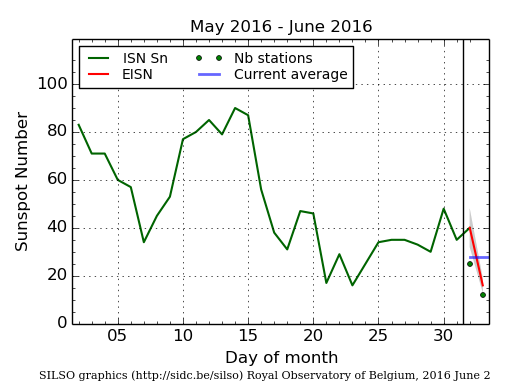
The daily Estimated International Sunspot Number (EISN, red curve with shaded error) derived by a simplified method from real-time data from the worldwide SILSO network. It extends the official Sunspot Number from the full processing of the preceding month (green line). The plot shows the last 30 days (about one solar rotation). The horizontal blue line shows the current monthly average, while the green dots give the number of stations included in the calculation of the EISN for each day.
Review of geomagnetic activity
Mostly quiet to unsettled geomagnetic conditions were observed throughout the week. The week started with Earth still under the waning influence of a high speed stream (HSS) from a positive northern coronal hole (CH). Solar wind speed decreased to values near 330 km/s late on 27 May, when a sector boundary crossing (SBC) occurred. The interplanetary magnetic field turned from away to towards the Sun. Early on 28 May, solar wind speed started a gradual increase to values near 550 km/s, in response to the HSS from a small negative southern CH.
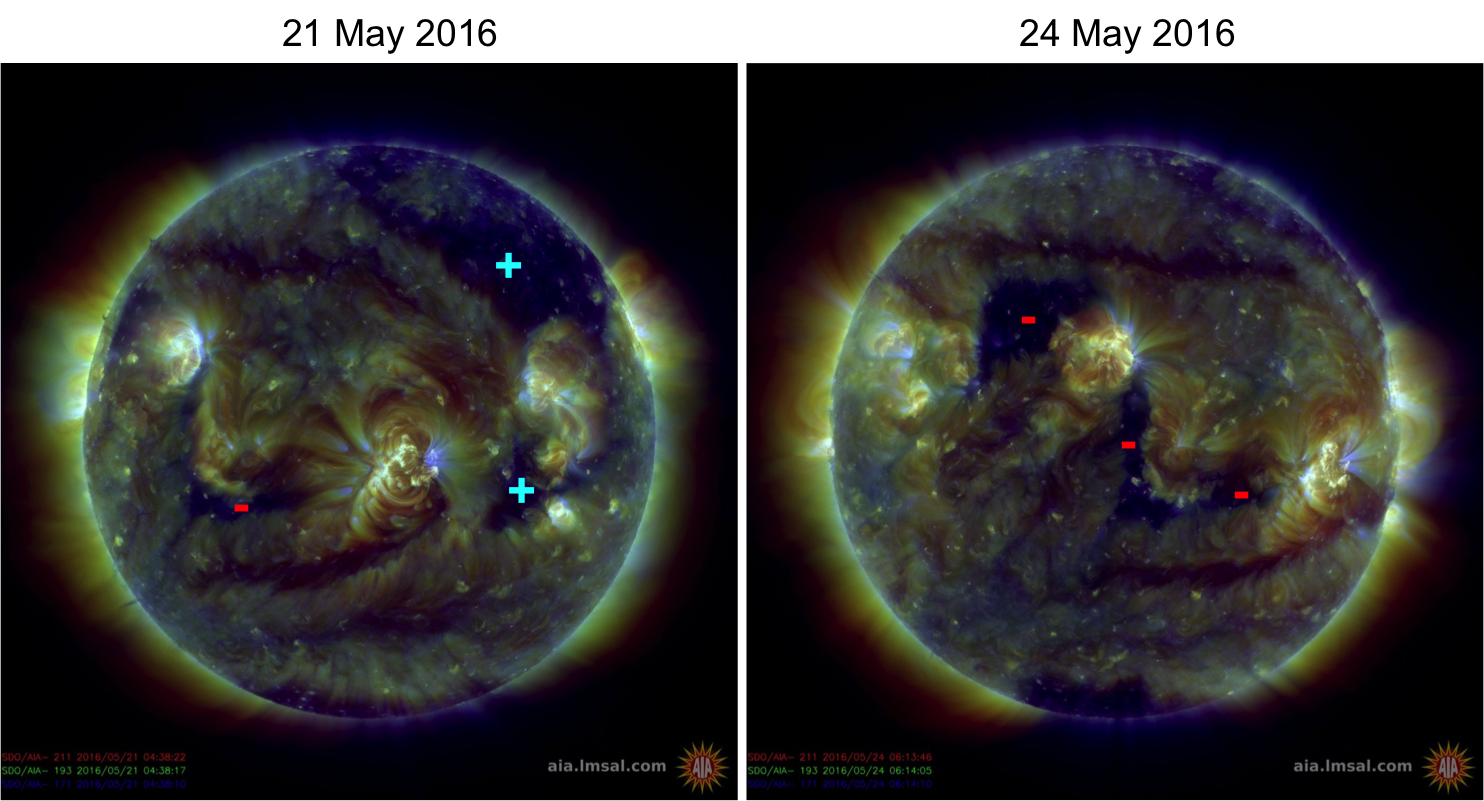
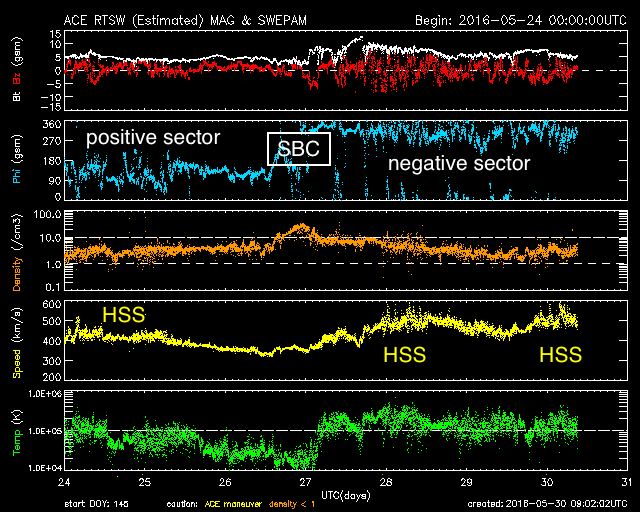
The weak disturbance resulted in active geomagnetic conditions as observed by Dourbes and in the Kp index during the 09UT-interval on 28 May, and during the 21UT-interval on 28 May (Dourbes only). Solar wind speed then gradually decreased to values between 400 and 450 km/s. During the afternoon of 29 May, solar wind speed picked up again under the influence of the HSS from a negative northern CH, resulting in active conditions early on 30 May (Kp only).
Review of ionospheric activity (23 May 2016 - 29 May 2016)
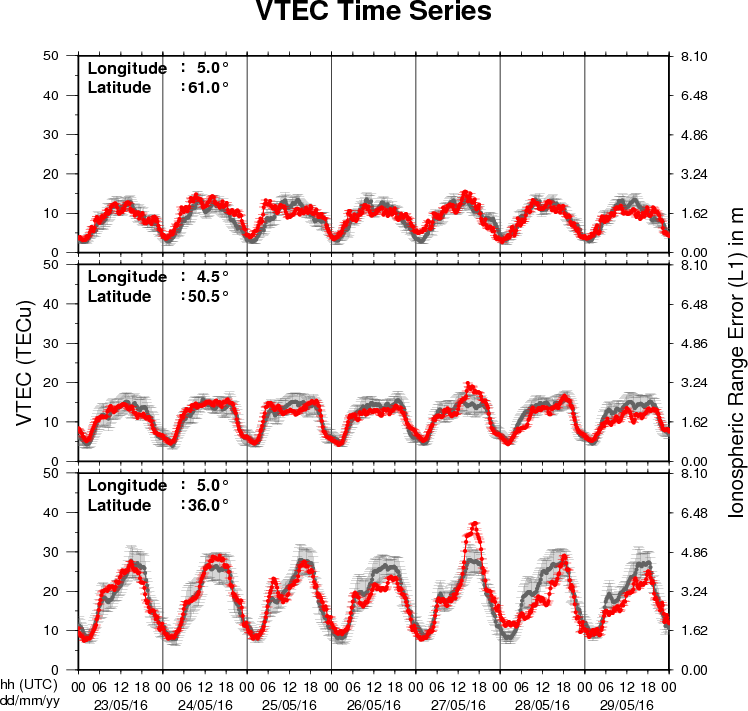
The figure shows the time evolution of the Vertical Total Electron Content (VTEC) (in red) during the last week at three locations:
a) in the northern part of Europe(N61°, 5°E)
b) above Brussels(N50.5°, 4.5°E)
c) in the southern part of Europe(N36°, 5°E)
This figure also shows (in grey) the normal ionospheric behaviour expected based on the median VTEC from the 15 previous days.
The VTEC is expressed in TECu (with TECu=10^16 electrons per square meter) and is directly related to the signal propagation delay due to the ionosphere (in figure: delay on GPS L1 frequency).
The Sun's radiation ionizes the Earth's upper atmosphere, the ionosphere, located from about 60km to 1000km above the Earth's surface.The ionization process in the ionosphere produces ions and free electrons. These electrons perturb the propagation of the GNSS (Global Navigation Satellite System) signals by inducing a so-called ionospheric delay.
See http://stce.be/newsletter/GNSS_final.pdf for some more explanations ; for detailed information, see http://gnss.be/ionosphere_tutorial.php
Future Events
For more details, see http://www.spaceweather.eu/en/event/future
Space Weather REDI Bootcamp
Start : 2016-06-07 - End : 2016-06-17
SW REDI summer Bootcamp is a two-week free training in space
weather, with the first week focusing on the fundamentals of space
weather and the second week on intensive forecaster training, with
alternative opportunities to discuss research topics with the CCMC
and NASA GSFC scientists.
The program is ideal for undergraduate and graduate students
interested in space weather forecasting or in space weather related
research but is also beneficial for scientists, engineers,
educators, mission operators, competitive high school students and
all others seeking to gain some basic knowledge regarding space
weather.
Website:
http://ccmc.gsfc.nasa.gov/support/SWREDI/bootcamp/
The Scientific Foundation of Space Weather
Start : 2016-06-27 - End : 2016-07-01
Website:
http://www.issibern.ch/program/workshops.html
Global Modelling of the Space Weather Chain in Helsinki, Finland
Start : 2016-10-24 - End : 2016-10-28
This event brings together solar, heliospheric, magnetospheric,
and ionospheric communities to discuss the current state and future
challenges in global modelling of the entire space weather chain.
Major developments in forecasting space weather, and understanding
the effects of solar eruptions requires increased communication and
collaboration of these often rather distinct communities. We
welcome submissions from these modelling communities and also
synergetic studies utilising both observations and numerical
models.
Website:
https://pnst.ias.u-psud.fr/sites/pnst/files/global_modelling_space_weather_oct2016.pdf
European Space Weather Week in Ostend, Belgium
Start : 2016-11-14 - End : 2016-11-18
The ESWW is the main annual event in the European Space Weather
calendar. It is the European forum for Space Weather as proven by
the high attendance to the past editions. The agenda will be
composed of plenary/parallel sessions, working meetings and
dedicated events for service end-users. The ESWW will again adopt
the central aim of bringing together the diverse groups in Europe
working on different aspects of Space Weather.
Website:
http://www.stce.be/esww13/
Solar Orbiter Workshop 7: Exploring the solar environs in Granada, Spain
Start : 2017-04-03 - End : 2017-04-06
This event will be hosted by the Instituto de Astrofisica de
Andalucia - CSIC. Please mind that on April 7th the 20th SWT
meeting will take place at the same venue.
Website: Unkown
New documents in the European Space Weather Portal Repository
See http://www.spaceweather.eu/en/repository
STCE - Cosmic Rays workshop: A brief history of the cosmic ray monitoring at RMI
Presentation given at the Cosmic Rays workshop
Check https://events.oma.be/indico/event/10/
http://www.spaceweather.eu/en/repository/show?id=602
STCE - Cosmic Rays workshop: Introduction and Research topics
Presentation given at the Cosmic Rays workshop
check https://events.oma.be/indico/event/10/
http://www.spaceweather.eu/en/repository/show?id=603
STCE - Cosmic Rays workshop: The Neutronminitor database (NMDB) and its applications to space weather
Presentation given at the Cosmic Rays workshop
check https://events.oma.be/indico/event/10/
http://www.spaceweather.eu/en/repository/show?id=604
STCE - Cosmic Rays workshop: GLE alerts as input for SEP forecasts
Presentation given at the Cosmic Rays workshop
check https://events.oma.be/indico/event/10/
http://www.spaceweather.eu/en/repository/show?id=605
STCE - Cosmic Rays workshop: Cosmic rays and dosimetry at aviation altitudes
Presentation given at the Cosmic Rays workshop
check https://events.oma.be/indico/event/10/
http://www.spaceweather.eu/en/repository/show?id=606
STCE - Cosmic Rays workshop: Radiation hazards for astronauts
Presentation given at the Cosmic Rays workshop
check https://events.oma.be/indico/event/10/
http://www.spaceweather.eu/en/repository/show?id=607
